Star Wars Armour
The Imperial army makes use of armoured vehicles for the same reasons that real-life armies do: their mobility, their armour, and their firepower. While real armoured vehicles may be tracked or wheeled, the Empire's repulsorlift technology adds a third category: repulsorlift armour. The Empire also adds a previously nonexistent category of armoured vehicle, which is the battle droid. All of these vehicle and weapon types have their strengths and weaknesses, so it is their proper combination that typifies the successful commander.
Before continuing any further, it may be worthwhile to discuss the justification for non-repulsorlift vehicles in the Star Wars universe. Although it is tempting to employ the Trekkie philosophy and assume that "more advanced" = "better", that isn't necessarily the case. If it were, then real-life armies would have replaced all of their field guns with guided missile launchers a long time ago. Repulsorlifts reduce the importance of terrain, but as with many technological developments, they introduce problems of their own: according to the SWEGWT, repulsorlift vehicles can be negatively affected by unusual planetary magnetic or gravitational fields (particularly in unusual environments such as worldships, which are man-made planetoids with artificially enhanced gravity), as well as specialized anti-tank weapons that target repulsorlift fields. They may also emit particular radiation signatures which can be easily tracked, thus further reducing their tactical value.
Moreover, repulsorlift vehicles apparently cannot move through the semi-permeable theatre shields employed by ground armies such as the Rebels or the Gungans. It has long been speculated that ground theatre shields prevented passage of repulsorlift vehicles for the simple reason that General Veers' AT-ATs attacked Echo Base without air support, even though TIE fighters should have been able to hover through at ground-skimming altitudes. However, we didn't see any canon support for this speculation until TPM, when the characteristics of the Gungans' theatre shield were demonstrated quite clearly: like Frank Herbert's "Dune" shields, the Gungans' shield blocked high-velocity projectiles as well as the slow-moving repulsorlift tanks and transports of the Trade Federation army. The only way to enter was to slowly "push" one's way through, as the battle droids did, while maintaining contact with the ground. Therefore, while the battle droids were eventually victorious over the Gungan primitives, they would probably have subdued the Gungans even more quickly if they had been equipped with light ground-contact vehicles like TIE Crawlers or AT-STs.
Tanks
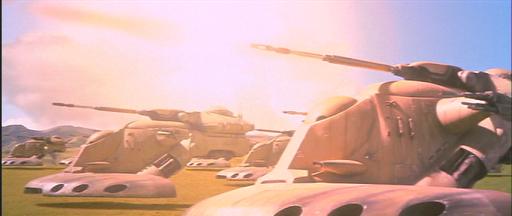
Trade
Federation tanks firing their main guns. Notice the six weapon ports
at the base,
through which they fire some kind of napalm
anti-personnel weapon.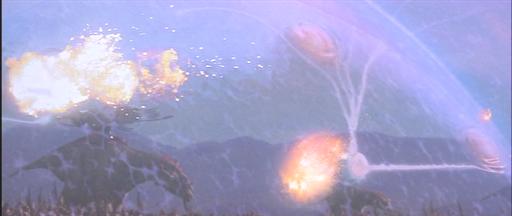
Weapon
impacts against the Gungan theatre shield. Notice how the
blasts
splinter into fragments, thus indicating that the tank guns
are firing physical
projectiles rather than energy beams.
AAT Trade Federation Battle Tanks: the real-life tank is distinguished by its fully enclosed armoured body, its field gun, and the fact that it performs no role other than combat (ie- it has little or no cargo capacity, unlike an APC). Using this definition, the TradeFed light tanks were the first tanks seen in Star Wars. These vehicles are repulsorlift tanks, and although it might be tempting to assume that they fall under the category of "battle droids", they appeared to be fully capable of supporting human crews as well. Instead of being autonomous units, each tank actually requires a crew of humanoid battle droids to operate it, and human crewmen could undoubtedly take their place. Like modern light tanks, the diminutive Trade Federation battle tanks carry two primary weapons: small-calibre field guns and anti-personnel weapons (its flamethrowers). In the picture above, you can see its main gun firing (it is described as a "laser" in the literature, but the shot clearly shatters upon impact, which indicates that these particular tanks are equipped with projectile weapons). Elevation and turret traversal limits are not known. According to the Episode 1 Cross-Sections book, its six anti-personnel incendiary launchers can also launch other types of projectiles, such as "bunker buster" high explosive shells and armour-piercing shells, and it encloses projectiles in a "plasma cocoon", which creates an aerodynamically optimized shape. The tank also has auxiliary blasters mounted on the sides of the turret (you can see them in the picture if you look closely) as well as a light coaxial gun. According to the ICS, its maximum speed is 55 km/h.
The Battle of Naboo demonstrated the weaknesses of this type of vehicle: its armour provided inadequate protection against the anti-tank blasters of the Naboo speeders, and its repulsorlift kept it from entering the Gungans' theatre shield, thus leaving the infantry droids and destroyers to bring down the Gungan shield generators by themselves. The TradeFed tank is a typical example of a light tank; it is small enough to be easily carried in large numbers on air transports, it is presumably much less expensive than a heavier vehicle, and its weapons are suited to anti-infantry or light anti-armour activities. The reasons for the Trade Federation's adoption of this vehicle are obvious: like a modern light tank, it would be easily outclassed by a heavier vehicle but the Trade Federation is merely a shipping company, and its opponents in battle are likely to be mere pirates, terrorists, primitives like the Gungans, or customers who are behind on their payments, rather than a full-fledged army.
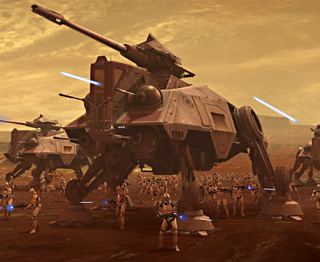 AT-TE:
the All-Terrain Tactical Enforcer is a six-legged tank with a maximum
speed of 60 km/h according to the SW2ICS. Its operational range is
said to be 500km, with air and rations for 3 weeks. Its armament
consists of 6 separate ball turrets (5 GJ per shot max) and 1 railgun
(variable yield, presumably varies with projectile type although it
is presumably far more powerful than the ball turrets).
AT-TE:
the All-Terrain Tactical Enforcer is a six-legged tank with a maximum
speed of 60 km/h according to the SW2ICS. Its operational range is
said to be 500km, with air and rations for 3 weeks. Its armament
consists of 6 separate ball turrets (5 GJ per shot max) and 1 railgun
(variable yield, presumably varies with projectile type although it
is presumably far more powerful than the ball turrets).
The deployment procedure is unusual; they can be airlifted by special LAAT-c repulsorlift units, which can drop them anywhere on the battlefield. The vehicles are dropped crewed and armed, and are combat-capable literally within seconds of hitting the ground. The combination of AT-TE tanks and LAAT-c repulsorlift deployment vehicles mean that a ground army using AT-TEs can be treated as a completely air-mobile force and can be deployed without a landing craft of any kind: a considerable advantage.
The railgun is unusual because projectile weapons are not common in Star Wars, but it would offer certain advantages, particularly against targets which rely entirely on shielding and lack strong armour and impact protection.
TIE Crawlers: the TIE crawlers are another example of a light tank, as described in the SWEGVV. The TIE Crawler is more of a traditional tank, dispensing with the repulsorlift drive in favour of a tracked propulsion system. Like the TradeFed tank, its design criteria emphasized cost reduction and minimal combat capabilities rather than cost-no-object fighting abilities. It even uses the control pod of a TIE fighter for its crew housing, in an obvious effort to save costs through modularity. The tank's maximum velocity is 90 km/h, which gives it mobility closer to a modern wheeled vehicle than a tracked vehicle, and its low mass means that it has very low ground pressure and it can navigate many types of terrain. It carries a pair of fixed-axis blaster cannons with limited elevation, which means that the entire vehicle must rotate in order to aim at a target, thus limiting its effective range. It also has a retractable, 360-degree rotating light turbolaser cannon in its underbelly that can presumably be used for close-range defense against infantry attacks, much like a modern tank's .50 calibre machine gun . The control scheme is similar to that of a standard TIE fighter, thus lowering training and instrumentation costs, and the tank was optimized for mass production. Like the light American Sherman tanks of WW2, the TIE crawler is intended to overwhelm an enemy through sheer numbers rather than individual combat prowess.
Reconnaissance Vehicles
Imperial recon vehicles perform much the same function as real-life recon vehicles: scouting and support for artillery and heavier vehicles. The AT-ST is the most famous Imperial scout vehicle due to its prominence in the Battle of Endor and its close ties to the infamous AT-AT, although the speederbike ranks a close second.
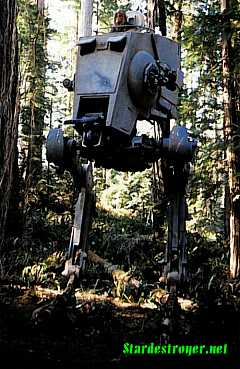 AT-ST
Walker: The AT-ST walker is a lightly armored, high-speed
scouting vehicle which was designed for speed and rapid deployment.
According to the SWE, it is 8.6 metres tall and it can exceed 90 km/h
on even terrain. Like all ground-contact vehicles, the AT-ST can push
its way through standard theatre shields, thus allowing it to go
where repulsorcraft cannot. Its legs are highly articulated and allow
it to traverse even the dense, difficult terrain of the Endor forest.
Like its lumbering AT-AT brethren, the relatively agile AT-ST carries
two chin-mounted heavy guns and two cheek-mounted light guns, thus
giving it the ability to engage both infantry and light armoured
vehicles. The SWEGVV states that its chin guns have an effective
range of 2 kilometres, which would be similar to the small mortars
often mounted on real-life recon vehicles. Their armour is light but
it can easily stop small-arms fire, and it takes several shots from
one AT-ST's guns to destroy another. It is possible that AT-STs can
also function as an Imperial ground equivalent of the real-life AWACS
aircraft, co-ordinating stormtrooper activity, sensor data, tactical
updates, etc. The disruption of AT-ST function in the Battle of Endor
coincided with a noticeable and sudden drop in stormtrooper accuracy
and efficiency- this could be attributed to coincidence rather than a
direct causal connection, but it nevertheless is a distinct
possibility.
AT-ST
Walker: The AT-ST walker is a lightly armored, high-speed
scouting vehicle which was designed for speed and rapid deployment.
According to the SWE, it is 8.6 metres tall and it can exceed 90 km/h
on even terrain. Like all ground-contact vehicles, the AT-ST can push
its way through standard theatre shields, thus allowing it to go
where repulsorcraft cannot. Its legs are highly articulated and allow
it to traverse even the dense, difficult terrain of the Endor forest.
Like its lumbering AT-AT brethren, the relatively agile AT-ST carries
two chin-mounted heavy guns and two cheek-mounted light guns, thus
giving it the ability to engage both infantry and light armoured
vehicles. The SWEGVV states that its chin guns have an effective
range of 2 kilometres, which would be similar to the small mortars
often mounted on real-life recon vehicles. Their armour is light but
it can easily stop small-arms fire, and it takes several shots from
one AT-ST's guns to destroy another. It is possible that AT-STs can
also function as an Imperial ground equivalent of the real-life AWACS
aircraft, co-ordinating stormtrooper activity, sensor data, tactical
updates, etc. The disruption of AT-ST function in the Battle of Endor
coincided with a noticeable and sudden drop in stormtrooper accuracy
and efficiency- this could be attributed to coincidence rather than a
direct causal connection, but it nevertheless is a distinct
possibility.
The Battle of Hoth provides a useful example of how the AT-STs would be utilized in a full-scale ground battle (as opposed to the jungle skirmish of ROTJ). We saw them escorting the large AT-ATs at the start of the battle, and it seems almost certain that their deployment would be similar to the deployment of recon vehicles around real-life armour. Our view of the battle was superficial at best, so we never saw many important details such as the position and eventual fate of the AT-STs. We also never saw the layout of the Rebel defenses, since our only view of the entire Rebel defense was of a small trench section. A logical defensive arrangement would have been the aforementioned fortified defense line, with two forward "wings" of infantry and light vehicles which would strike at the advancing Imperial vehicles from their flanks in a withdrawing action, using shoulder-fired anti-armour missiles such as Merr-Sonn PLX-2Ms and anti-armour cannons such as the rear-mounted guns on the Naboo "Flash" speeders, in hopes of inflicting early damage which is out of proportion to their numbers. As they are gradually forced to fall back toward the main defensive line, the vehicles would cover their retreat. As the Imperial armour continues to move toward the defense line, it would have taken an increasing volume of fire from the line itself, and it would also come within range of heavier anti-tank weapons positioned to attack from the sides. Traps and mines may have also been used, and if the Rebels had any armour, they would have probably tried to circle around behind the attackers.
AT-ATs are strong, but not invincible; at close range, they become vulnerable to attack on their vulnerable undersides. A vulnerability to close-in attacks from infantry and light vehicles is actually typical of heavy armour in real life, hence the usefulness of recon vehicles. Therefore, the importance of the AT-ST escorts involves all of the various flanking forces described in the previous paragraph. They would have to detect and identify these forces early, so that the AT-ATs can reorient themselves to destroy them before they can get close enough to be a threat (unless they are small enough to be destroyed by the AT-STs themselves). Another potential use for the AT-STs would be an encirclement action, where they would use their speed to circumvent the defense line and attack the Rebel rear echelons and staging areas, thus sowing confusion and disrupting front-line resupply efforts. The whereabouts of the AT-STs at the end of the battle is a bit of a mystery; they were no longer seen in support of the AT-ATs, which suggests that they were either destroyed or diverted to another area (or both; some moved away while those in direct support of the AT-STs were preferentially targeted and destroyed by Rebel artillery). They were also not visible when Luke boarded his X-wing during the evacuation, which suggests that if they had attempted an encirclement maneuver, they were either destroyed, repelled, or directed to an entirely different area (perhaps the headquarters area, which was completely overrun with Imperial troops long before Luke reached his X-wing).
QH-7 Chariot LAV: The Chariot is a command speeder. Like all speeders, it hovers above the ground (maximum 8 metres according to the SWEGVV) and it is capable of speeds in excess of 100 km/h, which are not great for a landspeeder but not unusual for a recon vehicle with light armour. Apart from its light armour, its defensive capabilities include ECM equipment and a single laser cannon. Like a real-life mobile command vehicle, it has an array of complex communications equipment as well as various other forms of tactical planning and co-ordination equipment.
Speeder Bikes: Aratech 74-Z military speeder bikes are fast-moving, highly maneuverable personal repulsorcraft. According to the SWEGVV, their top speed is 500 km/h and their maximum altitude is 25m. Speeder bikes are extremely inexpensive, low-maintenance vehicles are are very popular, particularly among scout troopers. Speeder bikes have very light armour plating, and a single blaster cannon for armament. Speeder bikes are normally used for scouting and perimeter patrols rather than direct combat, and their weaponry and armor are only capable of dealing with small numbers of ground troops rather than other combat vehicles.
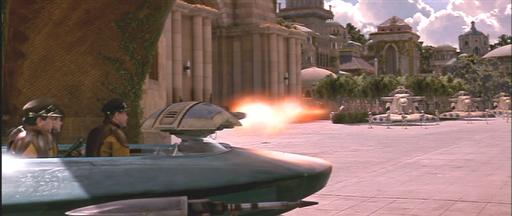
A
"Flash" speeder firing its anti-tank gun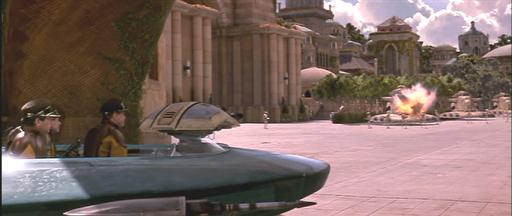
The
result of the blast. Notice that the armour is literally blown apart
at the point of impact,
and that it is at least six inches thick
as shown in the SW2ICS.
Naboo "Flash" Speeder: The Naboo "Flash" speeder is best known for firing the first shot in the Battle of Naboo. Its rear-mounted anti-armour blaster opened fire on a group of parked TradeFed battle tanks, and in mere seconds, several of the tanks were reduced to burning hulks. It is an open-top speeder so it provides little protection for its crew, and it has unusually large side-pod engines for a landspeeder, which suggest that it was built for speed. Its blaster was capable of punching a gaping hole through the armour of a Trade Federation battle tank, so it is an unusually large weapon for a vehicle that is ostensibly intended only for palace security. However, the existence of compact variable-yield weaponry would permit the use of such a weapon without undue bulk or inconvenience, unlike a large-calibre gun on a modern recon vehicle. A vehicle like this is not unprecedented in real life, as certain high-speed recon vehicles do mount weapons powerful enough to damage or destroy light tanks. For example, there are Humvees which are equipped with TOW missiles.
Naboo "Gian" Speeder: The Naboo "Gian" speeder is a heavier vehicle, sporting three separate blasters instead of one like the "Flash" speeder. It was seen bringing reinforcements during the Queen Amidala's preparations for the Battle of Naboo, although we never saw it engaging TradeFed forces in battle. Each of its three blasters is substantially larger than the single rear-mounted blaster on the "Flash" speeder. Since that blaster easily pierced TradeFed battle tank armour, it would appear that the "Gian" speeder's guns should be capable of destroying even larger vehicles. It is a more combat-capable vehicle than the "Flash" speeder. Its engines, instead of being mounted on broad side-pods for ease of maintenance, are tucked inside its body to prevent a smaller target profile. However, the cockpit is open and the vehicle is obviously built to evade enemy fire rather than withstanding it. Like real light recon vehicles with anti-tank missile launchers, this vehicle is capable of destroying even a fairly large tank if it can approach undetected and take the first shot, but it can't hope to engage one in open combat.
Trade Federation STAP: The STAP (Single Trooper Aerial Platform) is basically an air scooter. It has twin blasters of unknown but presumably low power, and it hovers at low altitude for scouting and light combat purposes. According to the Episode 1 Cross Sections book, it is fairly typical of civilian and military "airhooks" throughout the galaxy, although the engine placement on this particular model is probably specialized for droids; the exhaust hits the pilots' knees! However, for a human pilot, a speeder bike has similar armament, vastly superior speed, and more comfort, thus making it a better choice.
Mobile Infantry Combat Vehicles: The AT-AT Walker
General Capabilities
The most famous type of Imperial armoured vehicle needs little in the way of introduction. The AT-AT (All Terrain Armoured Transport) walker is a heavy assault vehicle which combines some of the characteristics of tanks, artillery, and MICVs. Although one could make an argument for its classification in any of those categories, its cargo capacity (40 men and 5 speeder bikes) leads to a primary classification as an MICV, albeit one of astonishing size and power. There are enough misconceptions about the AT-AT walker that it deserves its own discussion, so it will be discussed separately from other Imperial MICVs.
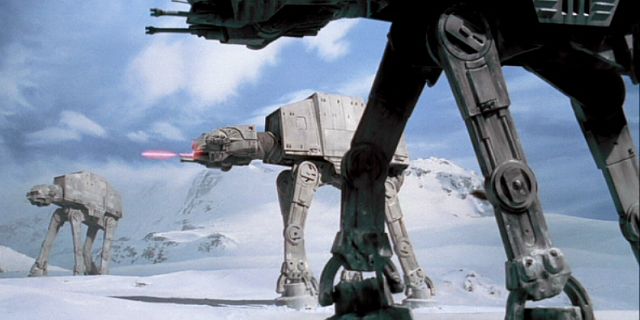
AT-AT
walkers advance during the Battle of Hoth
An AT-AT's basic capabilities are fairly well known: its armour shrugged off direct hits from Rebel artillery fire or snowspeeder guns in the Battle of Hoth. Its combination of two heavy chin-mounted guns and two light side-mounted blasters (seen above) have variable firepower and enough flexibility to target and destroy anything from infantrymen to enemy artillery pieces, low-flying aircraft, and even entire installations as far away as the visible horizon. However, its mechanized underside is vulnerable if you can get close enough to exploit it, and it has two dorsal vents which appear to be vulnerable points. Its maximum speed over flat terrain ground is said to be over 60 km/h, which would mean that it can cover its own length in roughly 2 seconds at full speed.
Size
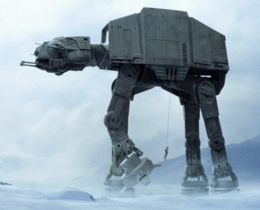 Given
the well-established anti-Imperial bias of the official literature,
it should not come as a surprise that the size of Imperial AT-AT
walkers has been grossly distorted in the technical books. The books
all state in unison that its height is 15 metres, but you can clearly
see from the picture at right that this is impossible. The walker is
more than 13.5 times the height of Luke Skywalker, even with his arm
extended upward to hold the grappling gun. If it were only 15 metres
tall, as the books insist, then Luke Skywalker would be less than 3½
feet tall! That is obviously ridiculous. Luke Skywalker is almost
exactly my height, and I can reach with one arm up to more than 2¼
metres without difficulty, so the picture actually shows a walker
which stands at 30 metres tall (that's a hundred feet, for those of
you who prefer archaic units), not 15 metres. In other words, New
Republic propaganda describes AT-AT walkers being only half as
big as they truly are.
Given
the well-established anti-Imperial bias of the official literature,
it should not come as a surprise that the size of Imperial AT-AT
walkers has been grossly distorted in the technical books. The books
all state in unison that its height is 15 metres, but you can clearly
see from the picture at right that this is impossible. The walker is
more than 13.5 times the height of Luke Skywalker, even with his arm
extended upward to hold the grappling gun. If it were only 15 metres
tall, as the books insist, then Luke Skywalker would be less than 3½
feet tall! That is obviously ridiculous. Luke Skywalker is almost
exactly my height, and I can reach with one arm up to more than 2¼
metres without difficulty, so the picture actually shows a walker
which stands at 30 metres tall (that's a hundred feet, for those of
you who prefer archaic units), not 15 metres. In other words, New
Republic propaganda describes AT-AT walkers being only half as
big as they truly are.
Tactical Strengths and Weaknesses
Of course, no discussion of walkers would be complete without answering the question: why? Why would the Empire build walkers, when they could use repulsorlift armour or tracked vehicles? The AT-AT walker suffers from numerous well-publicized weaknesses:
Poor concealment. Its sheer height means it can be easily seen from many miles away even with the naked eye, and the thundering noise of its crashing footfalls would reveal its position even to a blind man. Indeed, one could probably use seismographs to detect the movement of AT-AT walkers from well beyond the horizon, even in zero-visibility conditions.
High centre of gravity. The AT-AT's body is suspended so far off the ground that its centre of gravity is almost unthinkably high for a ground vehicle. It has even been suggested that an AT-AT could be easily toppled by firing a projectile at its side. However, its sheer mass precludes this possibility unless you have a weapon that can fire projectiles the size of a battle tank.
Poor close-in combat capability. The AT-AT's flexible neck permits engagement of vehicles in a broad forward firing arc, but it has difficulty with targets to its rear. It has no downward-firing weapons so it cannot engage targets which have somehow gotten underneath it (apart from attempting to crush them with its feet), and its agility is poor. Like real-life four-legged animals, it requires many steps in order to turn around, so it cannot react quickly to close-in targets.
High resource requirements. Such an enormous vehicle must also be very massive, hence the fact that its footfalls could be felt many miles away in the Rebel bunker. To put its sheer size in perspective, a single leg (not including foot) is roughly 16 metres long, 2.25 metres wide, and 1 metre thick. Therefore, even if we ignore everything but its legs and assume iron construction, we're already talking about more than a thousand tons of metal! One could theorize that the legs are hollow instead of being solid as they appear to be, but that would be extremely curious in light of their load-bearing requirements, not to mention the fact that we saw those legs take direct hits from Rebel artillery without perceptible damage. It is therefore likely that this vehicle's mass is on the order of several thousand tons. This seems like a lot of material for a single vehicle.
High ground pressure. Its feet, at roughly 4.5 to 5 metres in diameter, have less than 60 m² of ground contact area when one foot is in motion. This means that the vehicle's ground pressure will be several times atmospheric pressure. If its mass is 2500 tons, its static ground pressure with one foot up will be greater than 4 bars, and it will spike dramatically with each footfall, hence the thundering reverberation and ground quake. Modern armoured vehicles, in comparison, are usually designed to exert no more than one half atmospheric pressure on the ground. Now, 4 bars is nothing to get overly excited about (a scuba diver will experience it at 40 metres depth), but it is certainly enough to confine AT-ATs to solid terrain.
This list of weaknesses seems quite daunting, however they actually make sense in light of the AT-AT's combat role. Every type of real-life weapon is designed to perform a particular job, and its capabilities will be complementary with other weapon types, hence the importance of combined-arms tactics. The AT-AT is no different. It is not capable of waging ground war on its own, but its capabilities can be utilized very effectively within the larger framework of an Imperial ground army.
So what is the role of the AT-AT, and how can it possibly explain the weaknesses above? Well, we know it was used to attack a well defended target in TESB. Therefore, it must have been the most appropriate available weapon for the job. An attack on a well defended target with theatre shields, air support, and artillery is no easy task. You would have no air support, and no high-speed repulsorlift vehicles. Since the only known varieties of towed and self-propelled artillery use repulsorlifts for mobility, they would also be unavailable. This means you must be able to perform the combat duties of artillery, tanks, and MICVs without the wide array of vehicles you would normally use. No single vehicle can possibly perform all of those jobs as well as specialized vehicles would, so there would inevitably be compromises, and ironically enough (considering its classification as a transport), the most likely compromise would be its ability to function as an APC. Its ability to destroy enemy artillery, structures, and fortification is paramount, since no other weapons will be available for that task. Its ability to destroy enemy vehicles, low-altitude aircraft, and infantry units is secondary, since its great strength would reduce its vulnerability to such targets. Furthermore, smaller walker classes such as AT-STs should be available for support. Its ability to carry and support infantry is its least important attribute, since the destruction of enemy artillery and shield generators would open the door for various classes of specialized troop transports such as air drops and repulsorcraft.
Armed with this knowledge, we can see that some of the AT-AT's "weaknesses" are inherent side-effects of its combat role, while others aren't really weaknesses at all:
Poor concealment. It is often assumed that the AT-AT's poor concealment is an unfortunate design flaw, but how do we know it isn't intentional? As a weapon of assault, subjugation, and domination, it was undoubtedly designed with psychological warfare in mind, and deliberate high visibility would not be unreasonable in such a role. There are times when maximum visibility can actually be useful; for example, the US Navy uses enormous "supercarriers" even though they are obvious targets for enemy missile attack. However, their visibility serves the useful purpose of intimidation. Few sights can be more sobering for a tin-pot dictator than a huge, heavily armed American aircraft carrier and its task force, steaming within plain view of his coastline. In the Empire, highly visible weapons such as mile-long starships and hundred foot tall armoured transports are the psychological equivalent of "sabre rattling", and they work. The official literature actually describes entire star systems surrendering at the mere sight of a Star Destroyer, and soldiers being paralyzed with fear at the mere sound of AT-ATs.
High centre of gravity. The AT-AT's great height may initially appear to serve no useful purpose. However, upon closer examination we can determine that its height does serve a useful purpose, just like its high visibility. Remember that an AT-AT must be capable of long-range bombardment, but its weapons are limited to a line of sight. Therefore, if it was built low (like a modern MBT) with a gun only 2 metres above the ground, its range would be severely limited in all but the flattest terrain types, and it would be unable to shoot above even relatively small obstacles such as disabled vehicles. Even on perfectly flat terrain, its maximum range on an Earth-like planet would be limited to the distance to the visible horizon, which would be a mere 5 kilometres. However, by elevating its guns to a lofty 23 metre height, the AT-AT gains the ability to shoot over the top of small obstacles, it gains a broad view of the battlefield, and the distance to the visible horizon jumps from 5 kilometres to more than 17 kilometres. This number may sound familiar if you've watched TESB recently; according to General Veers' driver, his AT-AT destroyed the Rebel shield generator facility at 17.28 kilometres.
Poor close-in combat capability. The AT-AT's poor close-in combat capability is simply the inevitable side-effect of its sheer size and power. Real-life heavy armour is similarly limited at short ranges, hence the need for support from light vehicles and infantry. In the case of the AT-AT, it derives close-range support from its AT-ST escorts, which were seen in both TESB and ROTJ. While the AT-STs cannot do battle with enemy artillery, assault fortifications, and destroy large structures, they can support the vehicles which can, by keeping their flanks clear of infantry and light vehicles. This is a good example of the sort of complementary weapon classes which normally work together in real-life armies, as well as the Imperial army.
High resource requirements. The AT-AT's resource requirements are high by terrestrial standards, but a galactic Empire can casually call upon resources that would bankrupt a mere planetary government, or even an alliance of ten or twenty thousand planetary governments (never mind a tiny collective like the Federation). Therefore, although it may seem exorbitant from our frame of reference, it really wouldn't be an issue. The resources required for the construction of a single Star Destroyer make the cost of armoured divisions seem insignificant by comparison. Furthermore, the excessive use of metal might actually serve a useful functional purpose: its legs would be unacceptably vulnerable to stress fractures and artillery damage if they weren't solid, and the enormous feet are so massive that they would be virtually immune to any but the most enormously powerful land mines. In real life, land mines are dangerous to armoured vehicles because their undersides are typically quite weak. However, the massive, mostly solid feet of an AT-AT walker will eliminate this vulnerability; while it has a vulnerable underside, it would be unaffected by land mine detonations which are fifty feet below, and which would most likely be completely smothered by the aforementioned feet.
High ground pressure. This will definitely limit the AT-AT's terrain flexibility. However, it is the inevitable side effect of its mass, which is an inevitable side-effect of its size, which in turn is required for its long-range bombardment capabilities. Moreover, the AT-AT's powerful weapons were capable of destroying large structures such as the Rebel shield generator with a single blast. Such heavy weapons would undoubtedly produce significant recoil, and the friction provided by high-pressure ground contact will give the walker enough stability to repeatedly fire such blasts without sliding out of position or losing its aim point. Gun recoil is a significant problem for repulsorcraft, as demonstrated graphically by the Trade Federation battle tanks in the Battle of Naboo. They rocked noticeably back with each shot, thus forcing them to steady themselves and reacquire the target before the next shot. Repulsorlift towed artillery wouldn't suffer from this problem since it sits on the ground once deployed, but repulsor tanks and repulsor artillery will definitely have a poorer rate of fire than vehicles which are stabilized on solid ground, such as the AT-AT.
Troop Deployment
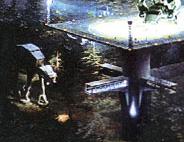 One
mystery about the AT-AT is its method of troop deployment. We've only
seen people debark from an AT-AT once, and that occurred in ROTJ when
Luke Skywalker was escorted from an AT-AT's "head" into a
special elevated platform (you can see the walker approaching the
platform in the picture at right). This didn't solve the mystery at
all, since the AT-AT cannot expect to have special elevated platforms
ready whenever someone wants to get out! Some of the official
literature describes the walker "kneeling" in order to
unload troops from a rear hatch, but no rear hatch is visible.
Furthermore, the process of kneeling down to debark troops is
extremely difficult to conceptualize. Its ankle joints don't appear
to have enough freedom of motion to permit such a maneuver, and the
very idea is questionable since it would involve a temporary loss of
mobility. It's hard to imagine anyone deliberately designing an
armoured transport in such a manner, but the official literature is
not unanimous on this claim.
One
mystery about the AT-AT is its method of troop deployment. We've only
seen people debark from an AT-AT once, and that occurred in ROTJ when
Luke Skywalker was escorted from an AT-AT's "head" into a
special elevated platform (you can see the walker approaching the
platform in the picture at right). This didn't solve the mystery at
all, since the AT-AT cannot expect to have special elevated platforms
ready whenever someone wants to get out! Some of the official
literature describes the walker "kneeling" in order to
unload troops from a rear hatch, but no rear hatch is visible.
Furthermore, the process of kneeling down to debark troops is
extremely difficult to conceptualize. Its ankle joints don't appear
to have enough freedom of motion to permit such a maneuver, and the
very idea is questionable since it would involve a temporary loss of
mobility. It's hard to imagine anyone deliberately designing an
armoured transport in such a manner, but the official literature is
not unanimous on this claim.
The SWICS shows troopers lining up to jump out of a side hatch near the back of the walker body, in much the same way as modern paratroopers jump out of an aircraft's side door. It explains that "AT-AT walkers can unleash their assault forces in several rapid waves using drop-lines with attached harnesses." This makes much more sense than the physically, tactically and logically questionable idea of the walkers kneeling to unload, since the AT-AT would lose none of its combat capabilities during this process. Troopers on speeder bikes could simply fly out of the side hatch, while other troopers could either slide down the drop-lines or use jet-packs and/or repulsor harnesses to deploy from the side hatch with a modicum of air mobility, so that there is no risk of being crushed by the AT-AT's elephantine feet if they deploy while it is in motion.
Armour
An AT-AT's armour system is capable of withstanding intense energy bombardment, as seen during the Battle of Hoth:
Snowspeeder blasters were useless against AT-AT armour. They produced nothing but bright flashes at the point of impact, without even so much as a small puff of smoke. When you compare this to the destructive effect of X-wing blasters on the surface of the Death Star, or even ordinary small arms on building and starship interiors, you can see the problem. Blasters normally vapourize a small amount of material, thus leading filling a combat area with thick, opaque smoke. Even against heavy blast doors, a blaster hit produces a small puff of smoke. The great strength of AT-AT armour is all the more impressive when you consider how the Naboo speeders' tiny anti-tank guns blasted huge holes through Trade Federation battle tank armour, and how X-wing guns blasted entire buildings on the Death Star's surface.
Even large Rebel artillery pieces had no effect whatsoever on AT-AT armour. One particular blast struck an AT-AT on its right rear leg, with very interesting effects. The armour glowed white-hot at the point of impact but in a fraction of a second, the heat apparently conducted away in all directions without even the faintest puff of smoke that normally accompanies even the smallest blaster hit. This indicates that the armour was thermally superconductive, but that would beg the question of why the Death Star, an "armoured battle station", wasn't made of the same material. A better explanation is that the apparent superconductivity of the armour has nothing to do with the armour itself, and is actually the result of an active energy diffusion field that acts along or perhaps even inside the surface of the armour. The Death Star, by virtue of having a much larger shield (albeit one that semi-permeable to slow-moving objects, hence the intrusion of the X-wings), was not expected to require such defensive measures. Therefore, it actually served as a useful demonstration of the effectiveness of starfighter blasters on unshielded armour, while the AT-AT walkers served as a demonstration of the impotence of light vehicle-mounted guns against shielded armour.
It has been suggested that AT-AT armour might be some sort of thermally superconductive but mechanically brittle ceramic, rather than a strong, ductile metal (which would suggest that it would be easily damaged by projectiles). However, this simply cannot be the case. No fewer than two AT-AT walkers were felled during the battle, and in both cases, they crashed to Earth without suffering any noticeable structural deformation. This is very impressive; the impact of such a massive object crashing to Earth from that height would normally be expected to deform hull plates, shear off bolts, and overwhelm welded joints, while the thickly armoured hulls of the AT-AT walkers in TESB suffered no discernible physical damage or deformation whatsoever.
Engineering Concerns
The design of a walker's legs seems to be a potential source of concern. A simple visual inspection of the legs will show that while they have a respectable 7:1 ratio of length to width when viewed from the side, they have a 16:1 ratio of length to width when viewed from the front. This has led to widespread concerns that they would be structurally weak, and highly susceptible to the phenomenon known as "column buckling". The best way to dispel myths like this is to perform an actual analysis, based on conservative assumptions of material properties.
The leg of a walker is pin-jointed at its knee and its base, but free at its end. Therefore, it is an example of a column with one free end and one fixed end, thus doubling the effective length to width ratio (for the purposes of Euler's Formula calculations) to 32:1. If we assume that a walker's legs are made out of present-day structural steel, then they would have an elastic modulus of 200 GPa. Note: do not confuse elastic modulus with with the entirely different concepts of yield stress (260 MPa for structural steel) or ultimate tensile stress (400 MPa for structural steel). Anyway, the moment of inertia I for the leg in bending would be bh³/12 = 0.1875, and Euler's Formula states that critical column buckling load P is (pi/L)²·EI. Substituting L = 32m, E = 200 GPa, and I = 0.1875 m^4, we get P = 360 MN, which is equivalent to the weight of 36,000 tons in a 1g gravity field. Remember that this is the critical load on just one leg, and a walker always has at least three feet on the ground. Therefore, even if we used a safety factor of 2, the walker's mass would have to exceed 72,000 tons to create a column buckling situation in its legs! A walker is massive, but not that massive.
Other engineering concerns raised in the past have included the issue of efficiency (although, as previously noted, the AT-AT was obviously not designed with efficiency as a priority) and articulation. The issue of articulation is an interesting one: to put it in the simplest possible terms, there are many methods of designing a robotic limb that can provide much more freedom of movement than the simplistic pin joint used in a walker's leg. In its current design, its turning ability is based entirely on rotations of the hip joint group (a less flexible version of the AT-ST hip joint). The most obvious alternative is some sort of ball joint, which would provide many more degrees of freedom and therefore superior agility. However, this is a huge combat vehicle which is far too large to evade fire. Therefore, its joints must be capable of withstanding direct hits from Rebel artillery, sustaining enormous structural loads (with correspondingly high friction), and exerting enormous forces (in order to move walkers whose mass is in the range of thousands of tons). Those requirements would take precedence over the number of degrees of freedom when choosing a joint type.
Mobile Infantry Combat Vehicles: Other
A5 Juggernaut: the A5 Juggernaut is a somewhat older version of the AT-AT. According to the SWEGVV, juggernauts are ancient vehicles that have been used ever since the reign of the Old Republic. They are wheeled vehicles with armour equivalent to that of an AT-AT, and they are capable of moving at 200 km/h over smooth terrain, thus giving them greater speed than an AT-AT but inferior terrain handling ability. A juggernaut carries up to 50 troops, and can also carry speeder bikes and even small repulsorcraft. Its armament includes numerous laser cannons and a medium blaster cannon, with similar overall firepower to an AT-AT. It also carries two concussion-grenade launchers for anti-personnel use. However, the Juggernaut is no longer actively produced, so spare parts availability is poor. In the end, its poor terrain-handling ability probably led to its replacement by the AT-AT walker.
AT-PT Walker: The AT-PT walker was designed to be a "personal walker" during the reign of the Old Republic. Some of these units are still in circulation, but the small and cramped AT-PT walker is inferior to the AT-ST and AT-AT walkers developed after the Empire took control. The AT-PT walker is only 3m tall, it is no faster than a lumbering AT-AT walker at 60 km/h, and it is armed with a twin blaster cannon and concussion-grenade launcher (ref. SWEGVV). Its firepower is equal to the firepower of an AT-ST walker, but its inferior speed, strength, and sensor equipment makes it a poor choice in battle.
MT-AT Spider Walker: The MT-AT transport is a highly specialized vehicle designed for superior terrain-traversal ability (they can even climb sheer vertical rock-faces), and orbital deployment. MT-AT's can be deployed in a manner similar to probe droids, being dropped from orbit with a specialized propulsion/heat dissipation shell that gets it to the ground safely without injury to its driver and gunner. The MT-AT "spider-walker" eschews heavy weapons in favour of a large number of light weapons, with one laser cannon on each of its eight legs and two additional driver-controlled laser cannons on the body (ref. SWEGVV). MT-AT walkers should only be used for surgical strikes and commando missions, since they lack the firepower to survive full-scale combat.
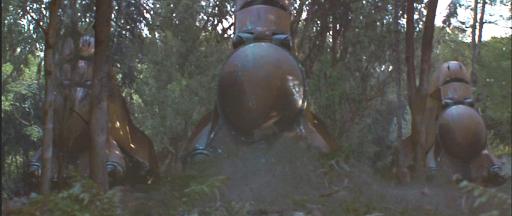
Trade
Federation droid transports. Notice how they easily move through a
dense forest,
because they are so heavy that they can simply knock
over the trees as they move.
Also notice that each transport has a
pair of two-gun turrets at the bottom.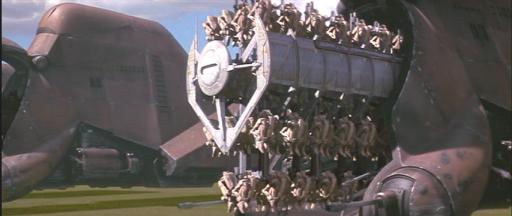
The
Trade Federation droid transport deployment mechanism.
MTT Trade Federation Droid Transports: The MTT, or Multi-Troop Transport, is a heavy repulsorlift vehicle which is designed to ferry troops to battle and provide support with its four anti-personnel blaster cannons. According to the ICS, it carries 112 battledroids (you can see this if you count the rows and columns of droids after they're deployed in the film). The ICS shows a "control signal receiver" in the MTT's cockpit area, which indicates that the MTTs functioned as repeater nodes for the control signal that was being broadcast from the orbital droid control ship. This suggests that the battledroids which are deployed from an MTT are slaved to that MTT, so if you can destroy the MTTs, you would disable the droids. Obviously, this is a very poor design decision, probably made in order to save money. Battledroids which display more individual initiative (such as those piloting the AATs and found onboard the Neimoidian ships or at the Battle of Geonosis) probably have independent processors rather than relying on a control signal. A single Trade Federation landing ship carries 11 MTTs in its cargo area. The Trade Federation also deployed pure troop transports (28 per landing ship), which you can briefly see during the initial landing sequence. They play no part in the plains battle.
Battle Droids
Battle droids perform a wide variety of functions in the Imperial army, acting as everything from infantry to armour, air support, and mobile artillery.
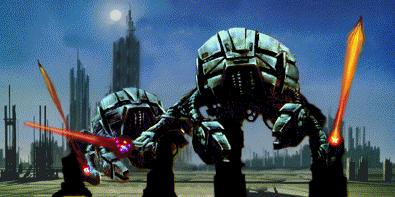 X-1
Vipers: the front-line Imperial heavy assault droid of the Empire
is the X-1 Viper automadon, seen at left. These droids are
manufactured at the industrial droid production facilities at
Balmorra. The X-1 is very heavily armed and is one of the few
combat droids to carry turbolasers. Once X-1 Viper droids are
unleashed onto a battlefield, they exterminate anything in sight and
continue to attack until they are either destroyed or victorious.
Their motivational programming incorporates advanced tactical AI but
no sentience or self-awareness, so that they will unhesitatingly hurl
themselves into battle without regard for their own safety. An
important feature of the X-1 Viper is its energy-absorbing armour,
which not only survives impacts from energy weapons but actually
channels that energy into its own weapons, as seen in
Dark Empire 2. This makes it virtually invulnerable to all but the
largest ground weapons, so the X-1 Viper is often used for mass
assaults upon heavily defended targets.
X-1
Vipers: the front-line Imperial heavy assault droid of the Empire
is the X-1 Viper automadon, seen at left. These droids are
manufactured at the industrial droid production facilities at
Balmorra. The X-1 is very heavily armed and is one of the few
combat droids to carry turbolasers. Once X-1 Viper droids are
unleashed onto a battlefield, they exterminate anything in sight and
continue to attack until they are either destroyed or victorious.
Their motivational programming incorporates advanced tactical AI but
no sentience or self-awareness, so that they will unhesitatingly hurl
themselves into battle without regard for their own safety. An
important feature of the X-1 Viper is its energy-absorbing armour,
which not only survives impacts from energy weapons but actually
channels that energy into its own weapons, as seen in
Dark Empire 2. This makes it virtually invulnerable to all but the
largest ground weapons, so the X-1 Viper is often used for mass
assaults upon heavily defended targets.
The X-1 Viper's armour has only one weakness: it feeds off energy weapons, but not from kinetic energy (projectile) weapons. Therefore, the armour has only moderate effectiveness against projectiles, so the X-1 Viper can be easily destroyed with fragmentation explosives and atmospheric-concussion weapons. It is highly unlikely that the Federation will be aware of this weakness, and even more unlikely that they will be able to quickly deploy specialized kinetic-energy weapons to take advantage. Their military organization heavily favours standardization over diversity, and their miniscule variety of ground weapons doesn't include the sort of weapons that would be required. Their phasers would merely strengthen the X-1 Viper assault droids in battle (much as they strengthened the energy-absorbing radiation emitters in "Booby Trap"). Nevertheless, this unusual characteristic means that while the X-1 Viper is virtually invincible against most of its intended opponents (who use "energy weapons"), it would be swiftly destroyed by a modern artillery bombardment. Some of the other common Imperial battle-droid models are listed below:
Balmorran SD-9: this basic battle droid is a fairly simple bipedal droid with conventional armour and blaster weapons. It mimics a normal human trooper, but it can be mass-produced quickly and cheaply. Like all droids, it is vulnerable to telekinetic attack from Jedi knights, as seen in Dark Empire when Luke Skywalker effortlessly destroyed attacking battle droids with a wave of his hand. It has basic shielding, armour, and blaster weapons but its combat AI is rudimentary and predictable, hence the ease with which SD-10 droids anticipated SD-9 tactics on Balmorra in Dark Empire 2.
Balmorran SD-10: these battle droids are a newer implementation of the basic SD-9 droid, but with improvements in every aspect. Their combat AI has been greatly improved and superior learning abilities have been incorporated. Although they still use basic blasters for firepower, their armour and shielding have both been greatly improved over the SD-9 model. The shields now incorporate point-of-impact enhancements, and their armour is now self-healing for superior battlefield survivability (ref. Dark Empire 2).
Shadow Droids: the Shadow Droids were used by Imperial Military Executor Sedriss in his campaign to discipline Balmorra after that world began arming New Republic criminals. These droids are actually sleek fighters controlled by droid brains, and they easily destroyed SD-10 droids in the Battle of Balmorra (ref. SWEGPM). However, the droids are not easily mass-produced; they carry the disembodied brains of dead Imperial ace pilots inside their motivational modules, empowered by the Dark Side of the Force (ref. Dark Empire 2). This prevents overly idiosyncratic behaviour, but it prevents mass manufacturing.
XR-85 Tank Droid: the XR-85 was deployed some time after the Battle of Endor. It is 32m long and more than 30m tall, thus making it similar in power to an AT-AT. Its tracked drive system keeps it from being able to traverse extreme inclines or highly variable terrain with the ease of an AT-AT walker, but it can travel through water as deep as 15m, and its top speed is 70 km/h. It is heavily armoured, and very heavily armed. Its primary forward-facing armament is a heavy medium-range particle-beam cannon, backed up by a pair of long-range turbolasers. It also carries four twin heavy-repeating blasters (two facing forward and two facing rearward), and a rear-firing Golan Arms DF9 anti-personnel cannon for protection against enemy infantry. This highly flexible weapon load-out is optimized for use against a wide variety of targets: its particle-beam is used to blast through heavy targets like bunkers and gun batteries, its turbolasers are used to destroy repulsor tanks and walkers, and its other weapons are used to cut down light speeders and infantry (ref. SWEGVV).
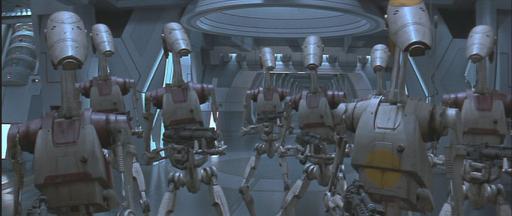
Battledroids
prepare to confront Obi-Wan and Qui-Gon aboard the TradeFed
battleship
Trade Federation Battledroids: Neimoidian battledroids are mass-produced, low-cost flimsy combat robots which were obviously designed to be hurled en masse into battle with little regard for combat survivability. A hit on the shoulder can knock one out, which is counter-intuitive since one would expect a battledroid to continue functioning in some fashion (albeit at reduced levels) even if an entire arm was blown off. Their fragility is indicative of a design which probably emphasized economy over redundancy and survivability. It is not entirely applicable to say that they are "armoured", since their bodies are made of metal which would constitute "body armour" in the modern sense. However, against Star Wars blasters, they can be considered to be un-armoured. Unlike superbattledroids, they do not carry built-in weapons, so they are equipped with standard blaster carbines which are capable of either semi-automatic or fully-automatic fire according to the TPM VD.
Their most famous weakness is the central point of failure at the droid control ship. When the droid control ship was destroyed in the Battle of Naboo, all of the battledroids on the surface went dead, supposedly because the "control signal" stopped. As a result, the VD says that they are totally incapable of independent thought and are immune to fear and remorse, meaning that they are completely slaved to the control ship. Even the yellow-hued officer droids are said to merely have larger power cells and priority communications. However, battledroids clearly displayed fear when confronting Jedi Knights aboard the TradeFed battleship in TPM, backing away and actually saying "uh oh" when they realized the Jedi had survived the nerve gas attack. Their human mannerisms were even more obvious in the Naboo hangar, with the officer droid playing games with Qui-Gon: "Ummm, Coruscant ... ummmm, that does not compute ... ummm ... ahhhh ... you're under arrest!" Moreover, the officer droid gave verbal orders to the security droid. Why would a mindless drone give a verbal order to another mindless drone, when both are being remote-controlled by a "control ship?"
This is by no means the only problem with the "mindless drone" idea. When the Republic ship landed on the TradeFed battleship, the droids in the hangar bay turned around to look at it; rather curious behaviour if they're all remote-controlled by a central computer which is perfectly aware of its arrival. Also, they do not share information, as demonstrated by the battledroid in the Theed hangar who did not instantly recognize Qui-Gon and the others even though they had already been in several pitched battles with other battledroids.
In short, the "mindless remote-controlled drone" description in the literature is simply unworkable. A few alternate explanations come to mind:
There are several classes of battledroids, despite their identical outward appearance. Some of them are mere remote-controlled drones, while others are fully independent units which can think and operate on their own. The drone class would presumably be designed to save money. However, the TPM novelization states that all of the droids on Naboo shut down simultaneously when the droid control ship was destroyed, so this explanation seems unlikely.
The "control signal" is not really a control signal at all, but rather, a mere "keepalive" signal. Its only purpose is to provide a sort of "dead man's switch" so that the droids can't revolt on their masters.
The droid control ship deliberately instructs the droids to engage in all manner of totally unnecessary and inefficient inter-unit mannerisms despite the fact that such behaviour is completely unnecessary and in fact detracts from combat performance. However, it is exceedingly difficult to imagine someone actually designing them in such a manner.
The droids are actually powered by this "control signal" somehow. However, there are no other examples of equipment being powered in such a manner, and it is not even known that it is possible. Worse yet, the VD explicitly describes power cells on the droids, which would obviate such a mechanism.
Of these, explanation #2 is the most likely. The droids shut down and some of them literally fell apart when the control ship was destroyed (a Gungan poked one and its head literally popped off), which is consistent with the idea that the Neimoidians designed them with a failsafe in case they needed to shut them all down at once. Of course, such a central point of failure is militarily foolish, but it is a foregone conclusion given the way the battle turned out (and the Neimoidians, after all, were not military thinkers; they were businessmen).
However, this vulnerability had apparently been fixed by the time of AOTC, since they were unable to shut down the droid army in the same fashion. The precise nature of this fix is unknown, although we may be able to derive some clues from C3PO's situation. His head was accidentally welded onto a battledroid body, and the battledroid's head welded onto his body. The result was curious: in both cases, the battledroid (either its head or its body) appeared to be in control. It may be that the body is remote-controlled by the droid control ship, while the head contains an independent processing unit which takes over if the control signal is lost (this would explain the infamous deleted scene in which the droid control ship was shut down and the droids stopped, but then quickly started themselves up again).
In conclusion, the Neimoidian battledroids were clearly designed as low-cost "grunts", which would only be effective against a trained enemy in great numbers. Predictably, one million of these units were deployed in the Battle of Geonosis (ref: ITW). When you realize that the Republic deployed less than two hundred thousand clonetroopers against them, their combat deficiencies become rather obvious.
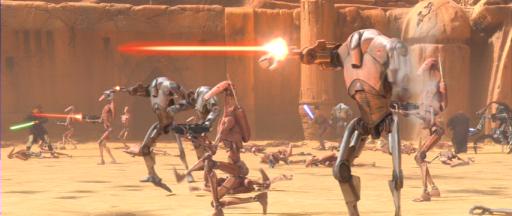
A
superbattledroid shakes off the loss of its left arm and continues to
fire
Superbattledroids: Superbattledroids are basically high-end Neimoidian battledroids. They share the same characteristic head shape, but with much better combat survivability (while standard Neimoidian battledroids can be knocked out of action with a hit to the shoulder that does not even appear to do serious damage, we saw a superbattledroid continue fighting with almost no interruption even after half of its left arm was blown off during the Battle of Geonosis). In addition, they may have a more autonomous AI than the low-end battledroids as well, given the fact that we saw one superbattledroid knock aside a damaged battledroid which was getting in its way, so violently that he literally knocked its head off and put it out of action.
Superbattledroids also carry a firepower advantage over low-end battledroids which is just as impressive as their improvement in combat survivability, if not more so. Instead of carrying standard-issue carbines as the low-end battledroids do, these ones are armed with integrated twin-barreled blasters which draw power directly from their onboard power cores. This provides them with a vastly greater supply of ammunition, thus allowing them to use full-auto fire in combat conditions without fear of rapidly depleting their weapons. Slow-motion timing of the weapon reveals that it fires twice for every 3 frames at 24 frames per second, for a firing rate of roughly 960 shots per minute.
In conclusion, superbattledroids would probably make a very effective, albeit quite expensive infantry force on their own. However, the Neimoidians' predilection for inexpensive low-end units means that superbattledroids constitute only a small fraction of a typical Neimoidian infantry. In effect, Neimoidians use them as elite units on the ground, in order to support the relatively large numbers of low-end battledroids. According to ITW, only 1 superbattledroid was deployed at Geonosis for every 10 normal battledroids.
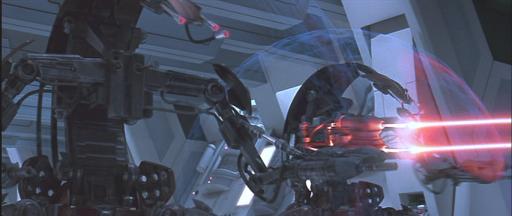
Droidekas
firing while shielded
Droidekas (destroyer droids): droidekas are even more expensive than superbattledroids, but they have the advantage of shielding. You can see the shield "bubble" quite clearly in the picture above. According to the TPM VD, they "can completely repel pistol fire and substantially weaken high-energy rifle or artillery bolts." They are well-suited to the standard Jedi combat tactic of reflecting blaster fire, since their own weapons do not appear to be powerful enough to penetrate their shields. Their peculiar method of deployment is to literally roll into battle like a large wheel. They can use their rolling speed in order to drive quickly into enemy territory while evading fire, thus potentially throwing defensive forces into disarray, and when they deploy, their shielding allows them to lay down heavy fire with good protection against counter-attack.
However, they do have weaknesses. Their shielding was ineffective against the heavy anti-materiél rifles of the clonetroopers in the Battle of Geonosis, and would be easily overwhelmed by the guns of a typical military vehicle. They are also apparently incapable of deploying their shields while moving. Against the mercenaries and light infantry forces against which the Trade Federation might often find itself in combat, they can be deadly shock troops. But against a well-armed military force such as the Republic Army, their great complexity and expense combined with their inevitably small numbers make them a wasteful use of resources.
As a result of their great cost, only 3000 of these units were deployed at Geonosis, and they did not appear to play a major role. This highlights the deficiencies of their design; the shielding system makes them too expensive to deploy in great numbers, yet it is not powerful enough to provide protection against heavy weapons.
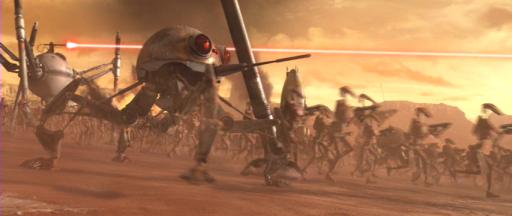
Homing
and Dwarf spider-droids advancing on the plains of Geonosis
Spider droids: Commerce Guild spider-droids were seen during the Battle of Geonosis and are their equivalent of tanks, with heavy guns (continuous-beam weapons for the Homing spider-droids and pulse weapons for the Dwarf spider-droids) and four-legged locomotion. Unfortunately, it was difficult to discern their effectiveness against Republic armour in the chaos of the battle. According to ITW, 15000 dwarf spider droids and 7500 homing spider droids were deployed during the battle.
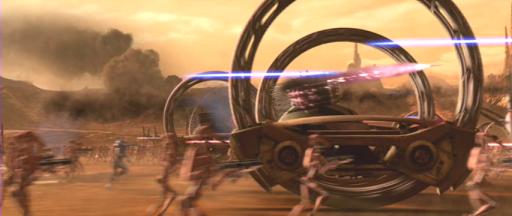
Hailfire
droids firing their missiles at Republic armour during the Battle of
Geonosis
Hailfire droids: InterGalactic Banking Clan Hailfire droids are large-wheeled fast-moving units which carry 30 Hailfire missiles. These missiles were proven to be highly effective against Republic armour, with a single hit being capable of destroying an AT-TE. They follow an unpredictable flight path to the target, presumably to reduce the odds of being shot down by anti-missile weapons. The wheel droids were the fastest-moving ground vehicles at the Battle of Geonosis, and their powerful missiles made them very dangerous to both armour and aircraft. The Republic LAAT gunships preferentially targeted these units for good reason: only 4100 of them were deployed during the battle, and they appeared to constitute the droid army's most effective anti-armour units.
Does the Federation have anything to match all of that armour?